Performance Comparison between the Deep Learning Kinetic Energy Functional AdvanceSoft25 and a Previous Machine Learning Kinetic Energy Functional#
Kohn-Sham DFT (KS-DFT), the most widely known method for Density Functional Theory (DFT) calculations for material property prediction, has the challenge that its computational cost increases on the order of with respect to the system size. Orbital-Free DFT (OF-DFT) was proposed as a method to solve this issue. In OF-DFT, the computational cost scales as , enabling extremely fast calculations even for large systems.
On the other hand, a major challenge for OF-DFT has been the lack of a known kinetic energy functional with sufficient accuracy, which significantly affects the calculation's precision. Under these circumstances, the development of machine learning-based kinetic energy functionals has progressed as a means to improve the accuracy of the kinetic energy.
As of August 2025, one of the most advanced machine learning kinetic energy functionals reported is CPN5, which uses non-local feature vectors, developed by Chen et al.1. By adding the integral of the electron density's gradient and Laplacian with a non-local kernel to the feature vectors, CPN5 achieved higher accuracy compared to conventional machine learning kinetic energy functionals that used semi-local feature vectors. However, its accuracy and versatility had not yet reached a practical level.
Therefore, AdvanceSoft Corporation has developed the deep learning kinetic energy functional AdvanceSoft25 (AS25), which applies a proprietary "field-deepening" algorithm, and has integrated it into Advance/OF-DFT. AS25 enables deep learning by extending graph theory to a continuous multivariate space and applying it to a "field," thereby achieving higher accuracy and superior versatility than conventional machine learning kinetic energy functionals.
In this case study, we conducted a performance comparison between the deep learning kinetic energy functional AdvanceSoft25 and the previous machine learning kinetic energy functional, CPN5.
Calculation Conditions#
The target structures are ten hexagonal semiconductors: Si, AlP, AlAs, AlSb, GaP, GaAs, GaSb, InP, InAs, and InSb. For this study, we used structure files obtained from the Materials Project.
We performed KS-DFT and OF-DFT calculations for each structure under the following conditions to obtain the ground-state electron density distribution.
| This Work | Previous Study1 | |
|---|---|---|
| Wave function cutoff energy (KS-DFT) | 1350 eV | 800 eV |
| Wave function cutoff energy (OF-DFT) | 1350 eV | 3200 eV |
| Energy convergence threshold | 1×10-4 eV | Not specified |
| Pseudopotential | OEPP | BLPS |
| Exchange-correlation functional | LDA | PBE |
| k-point sampling (KS-DFT) | 0.05 Å-1 | ~ 0.09 Å-1 |
| Preconditioner (OF-DFT) | Used 2 | Not used |
| Structure optimization | None | Performed |
We used Quantum ESPRESSO 6.7 (AdvanceSoft modified version) for the KS-DFT calculations. For the OF-DFT kinetic energy functional (KE functional), in addition to AS25 and the well-known TFλvW, LKT, and HC3 functionals, we also used a non-local model NL25 and a semi-local model SL25 for comparison. These were trained using the AS25 architecture but without the field-deepening component.
Calculation Results#
Prediction Accuracy of Electron Density Distribution#
The Mean Absolute Relative Error (MARE) of the electron density with respect to the KS-DFT result, defined by the equation below, was calculated for each KE functional. The results are shown in the bar graph below. The literature value of MARE for CPN51 is also plotted for comparison.
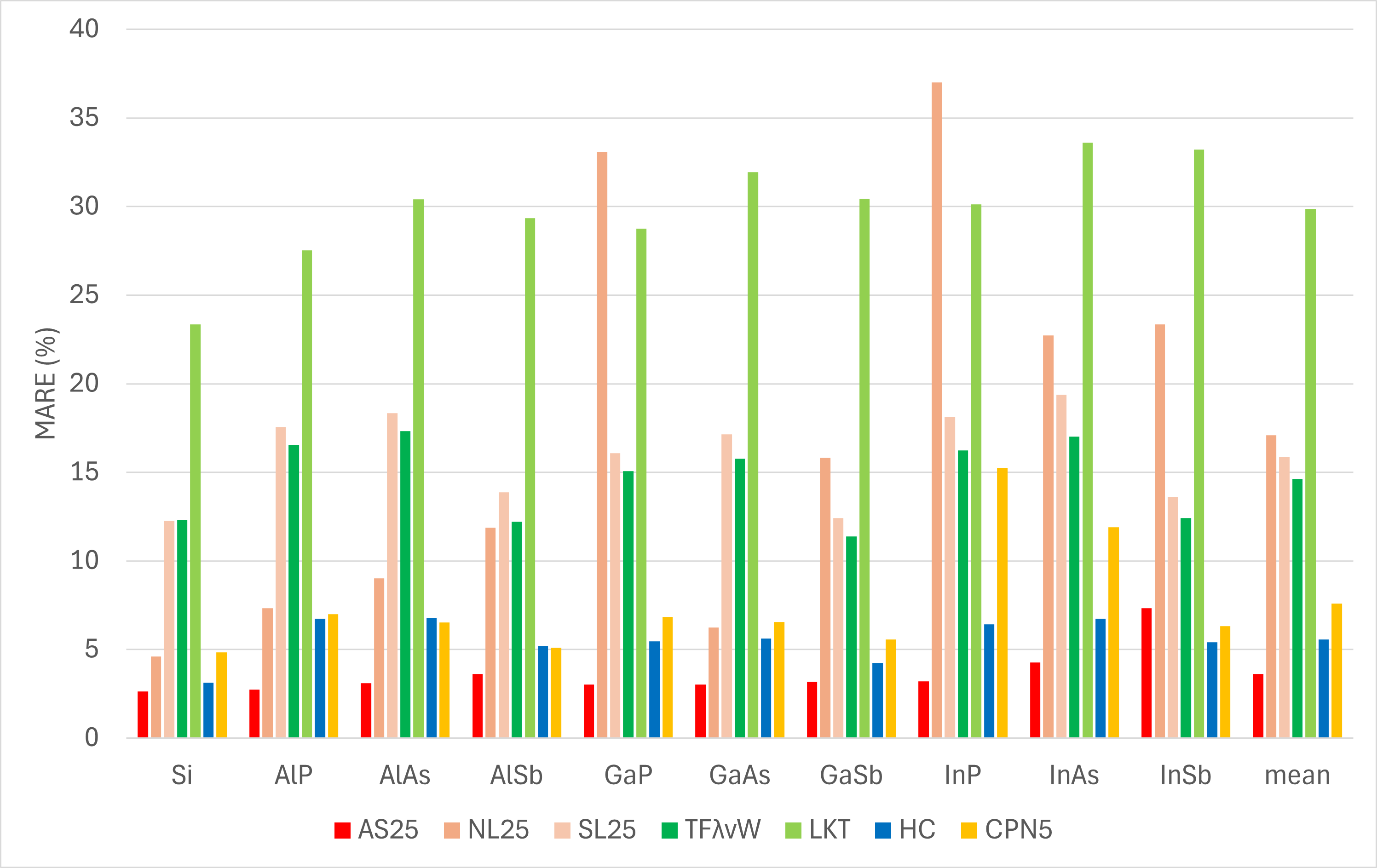
The figure above shows that for all structures except InSb, AS25 has a smaller MARE than any other functional, indicating that it can achieve high-precision electron density predictions. Even for InSb, the difference in MARE compared to HC and CPN5 is only a few percent. The average MARE over the 10 structures is 3.61% for AS25, which is less than half of CPN5's 7.59%.
Furthermore, while CPN5 was trained only on 10 cubic semiconductors corresponding to the 10 hexagonal semiconductors tested, AS25 achieves higher accuracy despite being trained on a completely unrelated set of approximately 4000 training data points4. This demonstrates that AS25 possesses overwhelmingly superior versatility.
Below are plots of the electron density for Si and GaAs. The left column shows the results from Advance/OF-DFT, and the right column shows the results cited from Chen et al.1. The horizontal axis corresponds to the position coordinates on a line parallel to the c-axis passing through the atomic center, and the vertical axis corresponds to the electron density value.
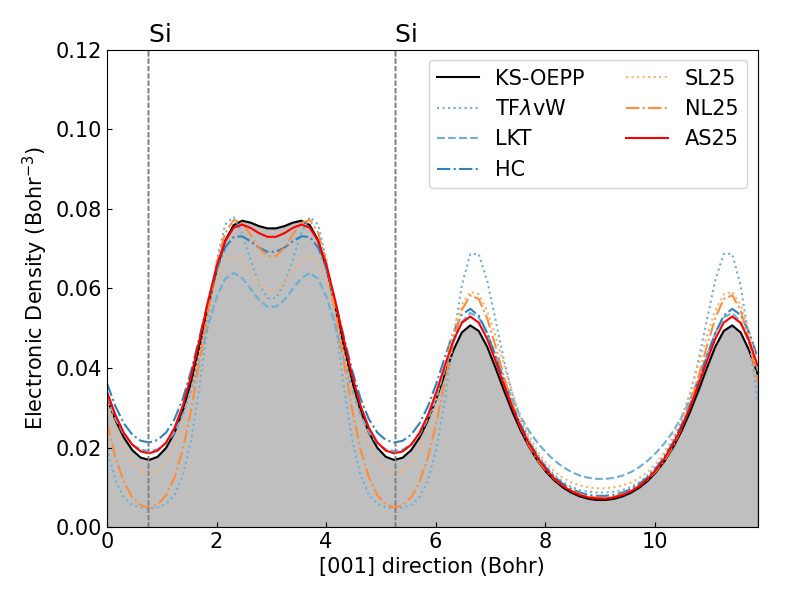
|
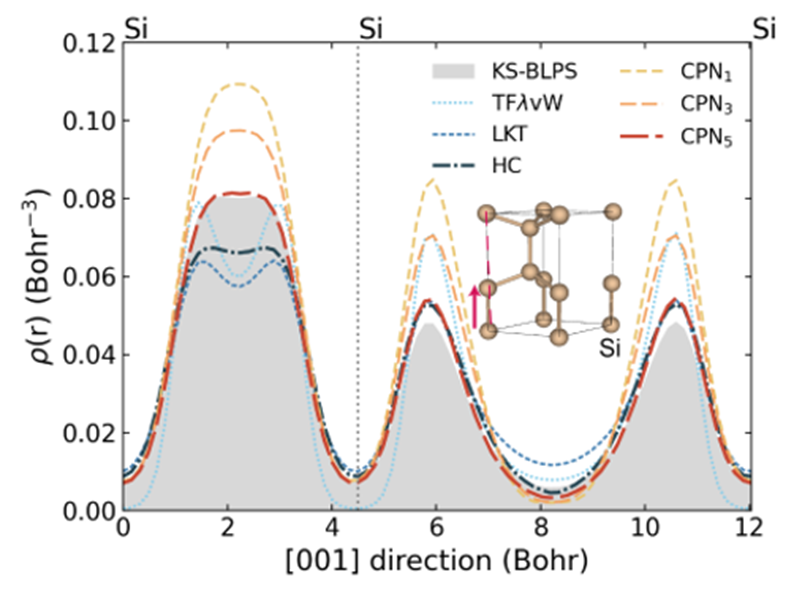
|
| Electron density distribution of Si (This Work) | Electron density distribution of Si (Previous Study1) |
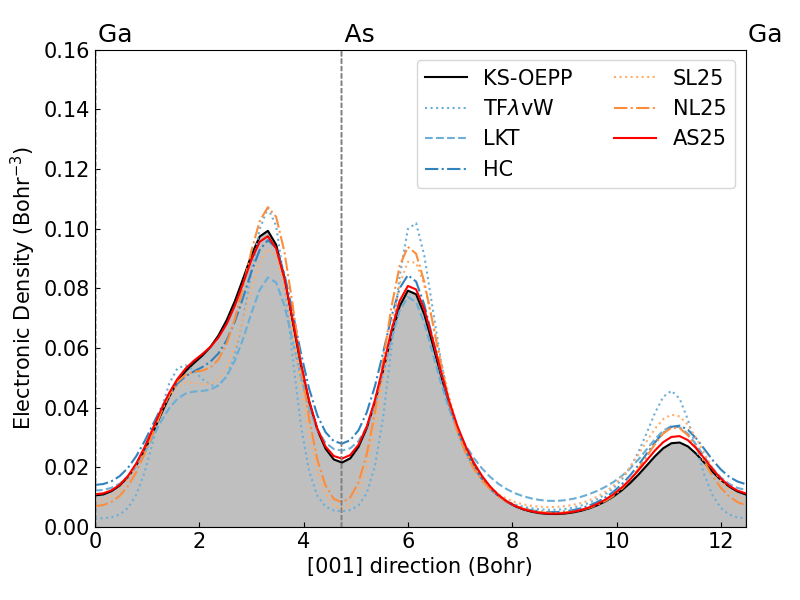
|
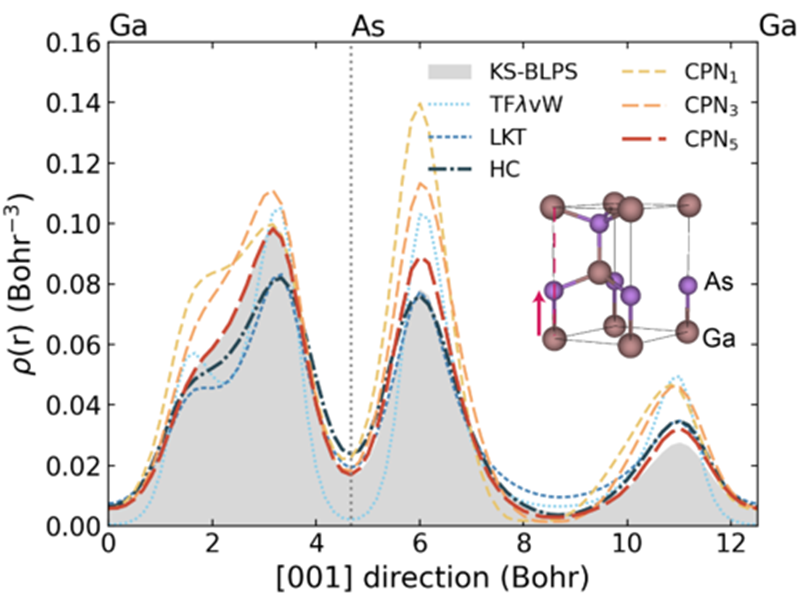
|
| Electron density distribution of GaAs (This Work) | Electron density distribution of GaAs (Previous Study1) |
In the plots for both Si and GaAs, the results for AS25 (red line) almost completely overlap with the KS-DFT results (black line), showing that it reproduces the KS-DFT results with higher accuracy compared to CPN5. Note that the slight difference in the KS-DFT electron density distributions between the left and right figures is mainly due to the use of different pseudopotentials and exchange-correlation functionals.
Conclusion and Outlook#
The results of this study demonstrate that the deep learning kinetic energy functional AdvanceSoft25 (AS25) possesses overwhelmingly superior accuracy and versatility compared to CPN5, one of the current state-of-the-art machine learning kinetic energy functionals.
By using AS25, it is possible to perform material property calculations for materials development with a lower computational cost than KS-DFT and with higher accuracy than conventional OF-DFT.
In the future, we plan to further improve accuracy by refining the training data, model architecture, and convergence algorithms. We are also advancing research and development to expand the supported pseudopotentials to all elements, aiming for more general-purpose use.
関連ページ#
- 深層学習Orbital-Free DFTソフトウェア Advance/OF-DFT
- 解析分野:ナノ・バイオ
- 産業分野:材料・化学
- Advance/OF-DFT Product Information
- Advance/OF-DFT Product Introduction Seminar
-
Sun, L., & Chen, M. (2024). Multi-channel machine learning based nonlocal kinetic energy density functional for semiconductors. Electronic Structure, 6(4), 045006. ↩↩↩↩
-
The preconditioner is an operator implemented by our company to suppress the high-frequency noise known to be present in the functional derivative of machine learning kinetic energy functionals. In this study, we used a damping function with a cutoff radius of 0.25 Å. ↩
-
The parameters for TFλvW were λ=0.2, for LKT a=1.3, and for HC β=2/3, λ=0.0. ↩
-
The training data consisted of KS-DFT calculation results for approximately 1000 crystal structures composed of 27 elemental species, as well as structures modified by adding vacuum layers or modulating volume and local potentials. ↩